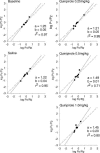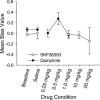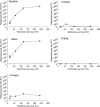The role of dopamine in reinforcement: changes in reinforcement sensitivity induced by D1-type, D2-type, and nonselective dopamine receptor agonists
- PMID: 16596971
- PMCID: PMC1389773
- DOI: 10.1901/jeab.2005.82-04
The role of dopamine in reinforcement: changes in reinforcement sensitivity induced by D1-type, D2-type, and nonselective dopamine receptor agonists
Abstract
Dose-dependent changes in sensitivity to reinforcement were found when rats were treated with low, moderate, and high doses of the partial dopamine D1-type receptor agonist SKF38393 and with the nonselective dopamine agonist apomorphine, but did not change when rats were treated with similar doses of the selective dopamine D2-type receptor agonist quinpirole. Estimates of bias did not differ significantly across exposure to SKF38393 or quinpirole, but did change significantly at the high dose of apomorphine. Estimates of goodness of fit (r2) did not change significantly during quinpirole exposure. Poor goodness of fit was obtained for the high doses of SKF38393 and apomorphine. Decrements in absolute rates of responding were observed at the high dose of quinpirole and at the moderate and high doses of SKF38393 and apomorphine. Changes in r2 and absolute responding may be due to increases in stereotyped behavior during SKF38393 and apomorphine exposure that, in contrast to quinpirole, were distant from the response lever. The present data provide evidence that sensitivity to reward is affected more strongly by dopamine D1-like receptors rather than D2-like receptors, consistent with evidence from other studies investigating consummatory dopamine behavior and the tonic/phasic dopamine hypothesis.
Figures












Similar articles
-
Prior D1 dopamine receptor stimulation is required to prime D2-mediated striatal Fos expression in 6-hydroxydopamine-lesioned rats.Neuroscience. 1999;94(2):505-14. doi: 10.1016/s0306-4522(99)00338-3. Neuroscience. 1999. PMID: 10579212
-
Neonatal exposure to epidermal growth factor induces dopamine D2-like receptor supersensitivity in adult sensorimotor gating.Psychopharmacology (Berl). 2007 Apr;191(3):783-92. doi: 10.1007/s00213-006-0595-9. Epub 2006 Nov 10. Psychopharmacology (Berl). 2007. PMID: 17096084
-
Dopamine receptors play distinct roles in sexual behavior expression of rats with a different sexual motivational tone.Behav Pharmacol. 2014 Oct;25(7):684-94. doi: 10.1097/FBP.0000000000000086. Behav Pharmacol. 2014. PMID: 25171081
-
Differential effects of dopamine receptor subtype-specific agonists with respect to operant behavior maintained on a differential reinforcement of low-rate responding (DRL) schedule.Pharmacol Biochem Behav. 2015 Mar;130:67-76. doi: 10.1016/j.pbb.2015.01.002. Epub 2015 Jan 10. Pharmacol Biochem Behav. 2015. PMID: 25584855
-
Behavioral responsitivity to dopamine receptor agonists after extensive striatal dopamine lesions during development.Dev Psychobiol. 1998 May;32(4):313-26. Dev Psychobiol. 1998. PMID: 9589220
Cited by
-
Animal models of obsessive-compulsive disorder: utility and limitations.Neuropsychiatr Dis Treat. 2015 Aug 4;11:1939-55. doi: 10.2147/NDT.S62785. eCollection 2015. Neuropsychiatr Dis Treat. 2015. PMID: 26346234 Free PMC article. Review.
-
Effects of the 5HT2C antagonist SB242084 on the pramipexole-induced potentiation of water contrafreeloading, a putative animal model of compulsive behavior.Psychopharmacology (Berl). 2013 May;227(1):55-66. doi: 10.1007/s00213-012-2938-z. Epub 2012 Dec 16. Psychopharmacology (Berl). 2013. PMID: 23241649
-
The influence of cost manipulation on water contrafreeloading induced by repeated exposure to quinpirole in the rat.Psychopharmacology (Berl). 2008 Apr;197(3):379-90. doi: 10.1007/s00213-007-1044-0. Epub 2008 Jan 12. Psychopharmacology (Berl). 2008. PMID: 18189126
-
The Role of Retinal Dopamine D1 Receptors in Ocular Growth and Myopia Development in Mice.J Neurosci. 2023 Nov 29;43(48):8231-8242. doi: 10.1523/JNEUROSCI.1196-23.2023. J Neurosci. 2023. PMID: 37751999 Free PMC article.
-
Apomorphine effects on frog locomotor behavior.Physiol Behav. 2007 May 16;91(1):71-6. doi: 10.1016/j.physbeh.2007.01.019. Epub 2007 Feb 8. Physiol Behav. 2007. PMID: 17355884 Free PMC article.
References
-
- Anderson K.G, Woolverton W.L. Concurrent variable-interval drug self-administration and the generalized matching law: A drug-class comparison. Behavioural Pharmacology. 2000;11:413–420. - PubMed
-
- Belke T.W, Neubauer J. A matching law analysis of the effect of amphetamine on responding reinforced by the opportunity to run. Psychological Record. 1997;47:483–498.
-
- Bindra D. How adaptive behavior is produced: A perceptual-motivational alternative to response-reinforcement. Behavioral and Brain Sciences. 1978;1:41–91.
-
- Egli M, Schaal D.W, Thompson T, Clearly J. Opiod-induced response rate decrements in pigeons responding under variable-interval schedules: Reinforcement mechanisms. Behavioural Pharmacology. 1992;3:581–591. - PubMed
Publication types
MeSH terms
Substances
Grants and funding
LinkOut - more resources
Full Text Sources

